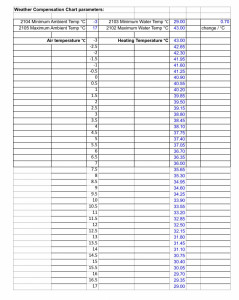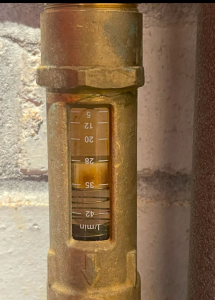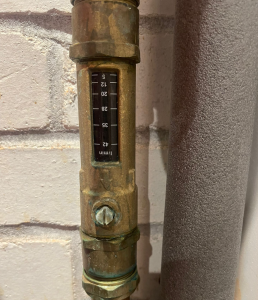Turning TRVs down to zero on all rads but the one that has no air nor water. After a while opening the bleeding valve on problem tad right open some water eventually came out so suspect a tonne of air or theres a blockage on this small Eskimo rad.
Anyone got any tips on an airlocked radiator? This one seems to be having issues
@crimson I don’t know what the experts might do but, when a radiator is plumbed in, it is ‘dry’ containing just air and filling is accomplished by opening the air vent at the top and then allowing it to gradually fill with water from the flow pipe. If you completely drain the offending radiator and then gradually fill it until water exits from the air vent - might this do the trick? Please note: I’m not a plumber, an expert or an installer but from observing radiators being filled in my own home, this is my suggestion. I’d be interested in any comments from those more knowledgable amongst us please. Regards, Toodles.
Toodles, heats his home with cold draughts and cooks food with magnets.
Thanks @toodles, Im awaiting the installers to get back to me (seemingly gone back to radio silence).
I’ve altered the WC to be as follows:
That’s 36C at 7C.
Currently temps seem to be around 19.5-20C in the living rooms like this.
note this is 3C above design at -3C.
How “bad” is this? I need to feed back to architect about current state. I suspect to get to temp I’d need to push to 45C and min temp of 30C. Which is well above design. Not really sure where to go with this, rads were doubled in output, hallway tripled essentially.
Still cycles often, but that small rad seemingly air-locked I cant imagine helps
@crimson A raise in flow temperature to 45 deg. C should not be too disastrous - my system hits the low 40’s some of the time on colder days and I think the highest I have observed was approx. 48 deg. C when it was -7 OAT. 45 deg. C is usually an acceptable temperature for LT heat pumps. Regards, Toodles.
Toodles, heats his home with cold draughts and cooks food with magnets.
Yeah, I’m just concerned that the design of the system is 40C at -3C ambient, if I keep pushing up percentage wise I’m getting quite above that and wonder if its simply rads are still undersized - which means their heat loss calculations are still far off for those rooms
I've created a separate thread to discuss WC settings as feel that's a more specific topic.
Still waiting on installers to come and sort that airlocked rad. Over a chat with one of the installers checked underfloor and other zones to ensure nothing up there. Something that I realised is the flow setter in the plant room looks black now.
Certainly wasn't like that before. And I keep finding air in the LLH, and rads upstairs at the front and any towel rads. Yesterday bleeding some rads upstairs, produced some rusty looking orange water. Mentioned to installer and he said they hot flushed the system when did the upsize not long ago and put in inhibiter so not sure why that's happened.
Here are photos of the flow setter (ignore the level it was taken when things weren't quite right) before, and now (with it black)
It’s been a while since last gave an update…
After a couple visits from a heat specialist, and revisits to the calcs. It’s been concluded that the low water volume in the front downstairs zone is a primary cause with the physically short low loss header likely seeing mixing further causing the Grant ASHP to cycle on and off as a delta isn’t maintained long enough - meaning the problematic zone (front downstairs primarily heated with Eskimo rads) isn’t performing.
The ASHP has been run as a test at 60% power by forcing nightmode. However the cycling was still seen (concept was to test is the ASHP simply oversized)
The solution is, the installers are going to replace the low loss header with a wall mounted buffer tank of up to 80 litres, acting as essentially a taller low loss header / mechanical break in the system (per Grant’s requirements) plus providing additional water volume to the system primarily to get some water content available when just the problem zone is on. Obviously the additional water volume is before the zones, but there was no logical place to out one in the downstairs front zone. Seemingly water content wasn’t accounted for and the installers noted that when the half height Eskimos were drained before the rad upsize, they had very little (believe around 6 litres total), so the hope is to balance water content across the 3 zones in essence (when the upstairs and UF go off not to be left with very little water volume).
I’ll report back once the work is complete.
Physical restrictions in the plant room has meant this was best option. It was considered to use an outdoor grant LLH that has 30 litres total capacity, however it would have meant shifting the ASHP forward, causing far more works and the worry was 30 litres might not be enough.
Further rad upsizing/altering zones, we couldn’t go for as the works involved / physical space meant we weren’t sure we’d get enough water volume anyway.
A long long journey so far. I’m crossing my fingers (and toes) that this will work (and hoping to finally see 21C in the living rooms!)
Posted by: @crimsonThe solution is, the installers are going to replace the low loss header with a wall mounted buffer tank of up to 80 litres, acting as essentially a taller low loss header / mechanical break in the system (per Grant’s requirements) plus providing additional water volume to the system primarily to get some water content available when just the problem zone is on. Obviously the additional water volume is before the zones, but there was no logical place to out one in the downstairs front zone. Seemingly water content wasn’t accounted for and the installers noted that when the half height Eskimos were drained before the rad upsize, they had very little (believe around 6 litres total), so the hope is to balance water content across the 3 zones in essence (when the upstairs and UF go off not to be left with very little water volume).
I’ll report back once the work is complete.
I confess I haven't followed the full ins and outs of this case but, as I understand it, your principal problem is that some rooms that are not getting hot enough.
Quite how the installers proposed modifications will address this escapes me, so I wish you good luck. For sure the Grant will cycle on and off if it is oversized and at moderate OATs, a buffer tank wont stop that it will just change the duty cycle. I don't understand the logic of the direction this is going in; personally I would be looking to run all zones simultaneously with no buffer tank and never get to a point where one zone only is on. Then balance the zones so the rooms are all at the same temperature (or have the required temperature differences) by adjusting the flows through the loops/rads.
If the buffer tank is absolutely necessary (which almost certainly it isn't) then I would still do the same, and additionally attempt to balance the flow rate either side of the buffer tank to minimise system distortion, which can quite easily cause a performance hit of 30%.
If the mods proposed by the installer work and the system operates efficiently post then that's great, I hope it does.
4kW peak of solar PV since 2011; EV and a 1930s house which has been partially renovated to improve its efficiency. 7kW Vaillant heat pump.
Thanks @jamespa,
I think over the almost 3 years we’ve attempted running all zones (Ive spent many hours with settings, balancing rads, closing off rads) and the issue just kept occurring. UFH zone (rear ground floor) of approx 45sqm would get to temp nicely on max temp of 40C on a WC. Upstairs balanced right down sits at 18-19c with my office at 21C. But downstairs, just won’t hit 21C. This is after rads were doubled and tripled in output. All with the 3 zone valves open.
They've run the calcs multiple times (as did the specialist), and the downstairs just caps at 20C even with all zones open as the delta just doesn’t seem to register from the 6 rads in the problem zone. Tried heat dumps with towel rads upstairs running full blast, it was “better” but not there.
Specialist wanted to temp bypass the LLH, leaving it just on return to prove there’s mixing but I think all involved just want a one time fix now.
In hindsight I would have invested in getting the front ground floor to be UFH. But cost was significant (this is a renovation type project not new build) It appears these 3 zones just don’t work together well.
We did discuss re-zoning, but that’s floors and ceiling work which no one wants due to cost and disruption.
I’ll let you know how it goes, the works will be done in a day once they source an appropriate buffer tank, then they’re going to monitor temps with me.
Posted by: @crimsonBut downstairs, just won’t hit 21C. This is after rads were doubled and tripled in output. All with the 3 zone valves open.
This is broadly what I remember from earlier and what worries me, as it is strongly indicative of a water flow problem rather (ie not enough heat being transported, or heat being lost in transport) rather than a source capacity problem (ie not enough heat being generated at source).
For sure this could be fixed by increasing the flow temp from the heat pump and restricting the other zones accordingly so they don't overheat, in short operating it just like the oil boiler. It is possible that a larger capacity heat pump is required to do this, because capacity drops as flow temp rises. However an approach based on raising flow temperature to overcome a transport problem will cost you dearly in terms of running costs, and is therefore something of a last resort. That said re-piping the buffer tank as a volumiser will increase the flow temp to the emitters by 5C without increasing the flow temp from the heat pump, and this may be enough.
Personally I would want to see and check the calculations that support the proposed modifications. I would also want to make some temperature measurements on the pipework from heat pump to the problem emitters, and either side of the problem emitters, to get a further handle on what the cause is and on the scale of the problem. If it is a flow or transport loss problem it might well be better solved by increasing the flow rate through the pipework in question by fitting an auxiliary pump. This will both transfer more heat to the problem emitters, and reduce the loss through the long run, without having to push up the FT from the heat pump. Of course that does not guarantee that a larger heat pump isn't also necessary, but I am pretty sure its best to regard the two issues (problem emitters and overall capacity) as separate problems to be considered independently.
Obviously you are closer to this and know the ins and outs better than I ever will, you know your installer and also your own propensity for doing measurement. Im merely saying what I would do in the circumstances you have described and as I understand them.
4kW peak of solar PV since 2011; EV and a 1930s house which has been partially renovated to improve its efficiency. 7kW Vaillant heat pump.
- 26 Forums
- 2,364 Topics
- 53.6 K Posts
- 172 Online
- 6,029 Members
Join Us!
Worth Watching
Latest Posts
-

How long will your energy contract last?
Some heat pump tariffs don’t run as long as a heat pu...
By Toodles , 12 hours ago
-

@morgan They are unsupervised these days, can’t get the...
By Toodles , 12 hours ago
-
-
RE: Octopus Cosy Heat Pump Owners & Discussion Thread
@kevh it's worth remembering that many lsvs only actual...
By JamesPa , 1 day ago
-

RE: Setback savings - fact or fiction?
Exactly. We only need to compare conditions, to decide ...
By cathodeRay , 2 days ago
-
RE: Balancing financial efficiency and comfort using the Octopus Cosy tariff
I found because I have very low heat loss I can set bac...
By RadWhisperer , 2 days ago
-
RE: Need Help Optimising My Rushed ECO4 Install: 12kW Bosch Heat Pump
Welcome @mickamills We too have an oversized 12kW Sa...
By Old_Scientist , 2 days ago
-
RE: My Powerwall 3 Consumes 3-4 kWh/Day in Self-Consumption: Is This Normal?
@caron I can confirm that the power usage of the PW3 is...
By Old_Scientist , 2 days ago
-
RE: Speedcomfort radiator fans
Thats true, but having tried (and succeeded) in constru...
By JamesPa , 2 days ago
-
RE: Solis S6-EH1P8K-L-PLUS – Why I Chose It and What I’ve Learned So Far
@bash brilliant, thanks for the feedback
By energy9165 , 2 days ago
-

RE: Heat Pump Heats the House… But It’s Not Cosy. Emitter Changes or System Tweak?
@alastair There I was, feeling grumpy, he said “Cheer u...
By Toodles , 2 days ago
-
RE: Grant Aerona: Is there a setting to keep the 2-port valve open during pump blockade
Depends on OAT. Mine cycles at OAT>10 and of course...
By JamesPa , 2 days ago
-
RE: New Fogstar 15.5kWh upright solution
@transparent My conclusion is as you have noted, tha...
By Bash , 2 days ago
-
RE: Mitsubishi Ecodan R290 10kW performance
And to you too. Wishing you a very enjoyable festive s...
By Sheriff Fatman , 3 days ago
-

RE: External pipework insulation
They do? But that isn't apparent from the photos we'r...
By Transparent , 3 days ago
-

RE: Say hello and introduce yourself
@velcro welcome to the forums. Please feel free start a...
By Mars , 3 days ago
-
Daikin EDLA11D3V3 DHW Settings
I have a newly installed EDLA11D3V3 which I'm still get...
By Velcro , 3 days ago
-
RE: Midea ASHP – how to set weather compensation
@curlykatie did you get sorted with this?
By MickaMills , 3 days ago
-
RE: MyVaillant Connect Regular Disconnect
Thanks. Yes, if the time is consistently 11pm every nig...
By buckwem , 4 days ago
Members Online
No online members at the moment








